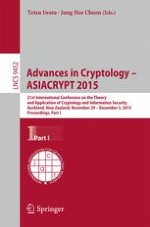2015 | OriginalPaper | Buchkapitel
Adaptively Secure Puncturable Pseudorandom Functions in the Standard Model
verfasst von : Susan Hohenberger, Venkata Koppula, Brent Waters
Erschienen in: Advances in Cryptology -- ASIACRYPT 2015
Verlag: Springer Berlin Heidelberg
Aktivieren Sie unsere intelligente Suche, um passende Fachinhalte oder Patente zu finden.
Wählen Sie Textabschnitte aus um mit Künstlicher Intelligenz passenden Patente zu finden. powered by
Markieren Sie Textabschnitte, um KI-gestützt weitere passende Inhalte zu finden. powered by
